The First Commercial Application of Frequency Synthesis


 |
| On the left: HP 5105A Synthesizer (top) with HP 5110B Synthesizer Driver ------- On the right HP 5103A Synthesizer HP Memory Project Collection |
The first HP 5100A Synthesizer was introduced in the 1963 catalog. It was a DC to 50 MHz signal source providing a highly stable and pure signal derived from an internal 1 MHz quartz oscillator or from an external frequency standard. The digital frequency selection was made in increments as fine as 0.01 Hertz by front panel pushbutton or by remote switch closure.
The basic principle that conducts the 5100 development was the following: "The sources that provide the highest frequency stability are single frequency sources, commonly called "Frequency Standards." Having these high quality standards to hand, it is natural to look for some method to translate their stability to other desired frequencies. This translation when the operation is something more than a single arithmetic operation, is commonly know as frequency synthesis. Hence, a variable frequency synthesizer is an instrument that translates the frequency stability of a single frequency standard, to any one of many other possible frequencies, usually over a broad spectrum."
The 5100A was of the "Direct Synthesis" type which simply performs a series of arithmetic operations on the signal from the frequency standard to achieve the desired output frequency. The direct synthesis approach has the pronounced advantages of permitting fine resolution and fast switching (lower than 1 millisecond for any frequency change), as well as an extremely clean output signal. On the same principle, an UHF version of the same instrument, the 5105A (shown in the photo above) would be introduced in 1967 to cover the 0.1 to 500 MHz spectrum with a 0.1 Hertz resolution.
More information about the Model 5100 Series Synthesizer can be found in the NEWS chapter of this web site. A complete article dedicated to this instrument was added on March 30, 2007, just after a fully functional unit was found on the French second (perhaps third or fourth :) hand market and added to the HP Memory collection. More recently, in 2014, a Model 5103A was also added to the collection. Related HP Journal articles and Application Note N° 96 are also available from that link.
Important comments about the 5100A Synthesizer project, are given by Bill Hewlett in the introduction of his book: "Inventions of Opportunity" edited in 1983:
"The development of the synthesizer was of additional interest in that it marked a change in HP's product-development procedure. Most prior developments were basically a one-person, or at most a small-team, short-term effort. In contrast, development of the frequency synthesizer was distinctly a team effort, requiring almost 40-man-years of engineering spread over a period of about three years—a major commitment to a new technology. This effort resulted in an instrument that provided almost unheard of resolution, and had an added advantage in that it was electrically programmable—an important feature in light of the rapidly developing field of automated testing."
Complexity of the 5100A synthesizer described by Bill Hewlett, is clearly illustrated by looking inside the instrument.
| HP 5105A Synthesizer, UHF Deck swung out |
 |
| HP 5105A Synthesizer, opposite side of the UHF Deck shown above |
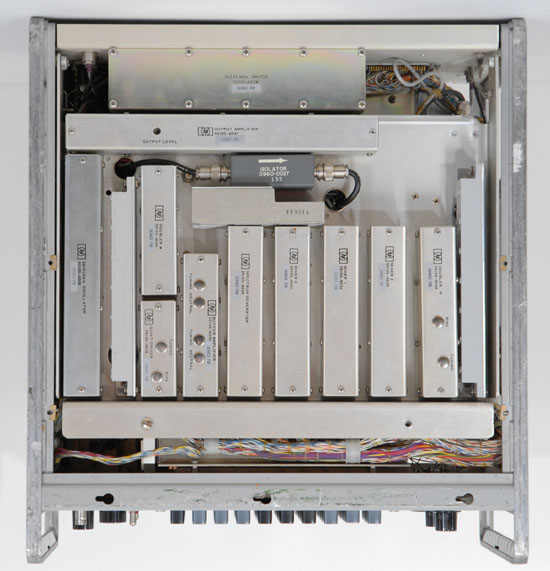 |
"About twelve years ago the digital frequency counter made its commercial debut. It revolutionized the art of frequency measurement; and a tedious, complex process of multiple heterodyning was reduced to a simple act of plugging in the signal and reading the answer. The tremendous time saving more than justified the cost of the counter and these instruments have become ubiquitous. They are found today in applications undreamed of a decade ago.
With the advent of the digital frequency synthesizer I believe we face an analogous situation. Here we have a single instrument that can generate any frequency over a range far greater than most oscillators or signal generators — a frequency known to quartz crystal accuracy of a part in 10E10 or better. This one instrument can do the work of a whole battery of general and special-purpose generators and do it better and more conveniently. The initial model has been engineered to the most exacting specifications and construction to meet the need for a high-performance instrument. Later lower-priced models will provide high performance over a reduced frequency range.
It will be very interesting to watch the applications develop for frequency synthesizers. Almost certainly they will become as common as counters. Almost certainly there are applications in your own work where a synthesizer would save time and money and do a better job."
Thanks to the frequency synthesizer, testing frequency sensitive devices could now be done automatically, rapidly, with great precision and with a spectrally pure stimulus. As an example of one of many applications made possible by a synthesizer's remote programming capability, the plot below shows the response of a single side band crystal filter. Less than one minute was required for the complete plot.
| Crystal Filter Response Plot. From Application Note Nbr 96, page 24. Courtesy of Hewlett Packard Company |
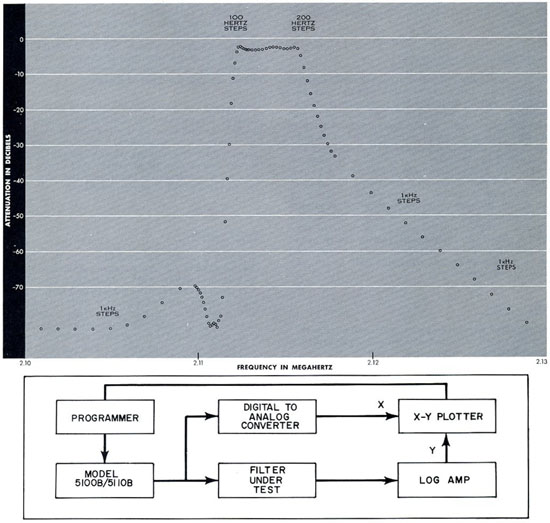 |
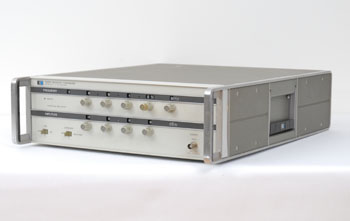 |
HP 3320B Synthesizer |
After thirty years of leadership in the traditional RC oscillator, the next step for HP was to add the advantage of the synthesizer technology to this product line.
Programmability, high accuracy in frequency and level setting, waveform purity, were some of the capabilities being asked of wide-range signal sources in 1972.
To meet these needs, two new synthesizers were developed. Each had a frequency range extending from well below 1 Hz up to a maximum of 13 MHz. Both of these instruments used Indirect Synthesis to keep costs down, but at the same time a purity of waveform some 20 dB better than that usually associated with indirect synthesis was achieved. The lower-priced instrument of this pair was the 3320A. It performed the functions of the familiar wideband test oscillator where amplitude control is not critical, but with significantly greater precision in frequency. For high precision in output level setting, the Model 3320B, (shown above,) uses a precision leveling circuit for its output. The 3320B had a direct-reading, four-digit amplitude control from -69.99 dBm to +26.99 dBm with 0.01 dB resolution.
Introduced in 1972 these instruments were the last generation of HP programmable instrument not yet HP-IB compatible. Various options gave them programmability from different interfaces like Parallel BCD, or ASCII remote control.
Before year 1973 there had been two distinct types of signal sources in the market place, each fulfilling a specific range of applications. One of these is the familiar signal generator (e.g. HP 606, 608, 612, etc.), and the other the synthesizer (e.g. HP 5100, 5105, etc.). In many cases both are necessary even in the same test set-up. Hewlett-Packard's 8660A/B Synthesized Signal Generator family is a new solution to this hybrid application. It combines the stability, programmability and frequency resolution of a synthesizer with the modulation and voltage calibration of a high-quality signal generator. This compact, all solid-state system has the versatility of plug-in modulation and RF sections and features directly computer-compatible programming of frequency, voltage level, and modulation.
To accomplish the synthesized aspect of this generator's performance, the indirect synthesis approach has been used. There are seven L-C tuned oscillators, each phase locked for stability and accuracy. A crystal oscillator at 10 MHz is the ultimate source, and all internal signals are referenced to it. Picture below outlines the 8660 family. There are two mainframes, each fulfilling separate requirements. The 8660A with a minimum of front panel controls is suited for systems applications; the 8660B with many new front panel features is a powerful bench instrument. Besides these different mainframes and plug-ins, there are other options available to narrow the choice of instrument further toward a specific application.
| From Selected Reprint of the Hewlett Packard Journal "8660A/B Synthesized Signal Generator" - PN 5952-1169 Courtesy of Hewlett Packard Company The 8660 system poses for a family portrait. 8660A (left rear), 8660B (right rear), are basic mainframes. Modulation facilities are added with 86632A Modulation Section (near left) in central plug-in position, or 86631A Auxiliary Section (near right) is substituted. Near center pair of plug-ins are RF Sections, 86601A for 0.01-110 MHz & 86602A for 1-1300 MHz |
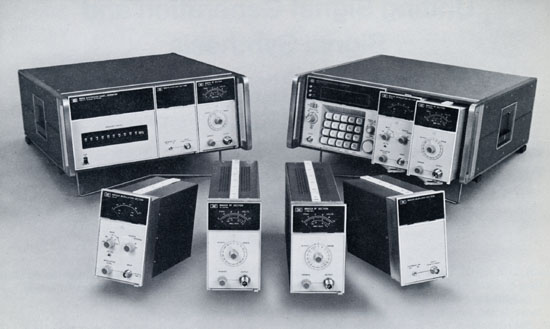 |
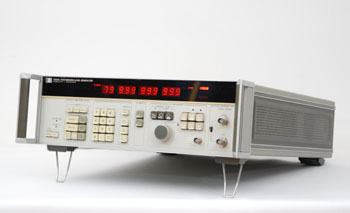 |
HP 3335A Synthesizer |
"Fractional-N" Synthesis technology was introduced for the first time with the HP 3335A Synthesizer in 1977.
"Fractional-N" Synthesis technology is impossible to be described here. More than 20 pages are dedicated to its description in the Theory of Operation chapters of the 3335A Service Manual.
An interesting article written by Gary Appel was published in the November, 2000 issue of "RF Design" Magazine. It is a clear and efficient way to understand this complex technology. It can be downloaded in PDF format from the following link:
The main advantage of the Fractional-N Synthesis technique is to permit the phase locking of a Voltage Controled Oscillator (VCO) to a fractional harmonic of a reference oscillator. That is, the oscillator frequency is equal to the number N.F times the reference frequency, where N and F are positive integers. Fractional logic dividers are inserted in the phase lock loop, allowing the VCO to be locked at any frequency inside its tuning range. Obviously this result is only obtained at the cost of much more added circuitry, but it is achieved by a single phase lock loop. A considerable economy compared, for example, to the 7 phase lock loops needed in the 8660 synthesizer, using the traditional Indirect synthesis technique. And above all, the frequency resolution is far better: One milliHertz up to 80 MHz for the HP 3335A.
Another particular characteristic of the 3335A was the precision of its output level. At the end of the 70s, increasing channel capacity of Frequency Division Multiplex (FDM) systems continually placed more stringent requirements on the testing of transmission parameters. This, in turn, placed further demands on test equipment used to design and maintain FDM systems. One such area where new standards of performance were required was amplitude control. To meet these performance standards, the 3335A incorporated a state-of-the-art attenuator resulting in an accuracy of up to +/- 0.03 dB over the 80 MHz frequency range. This accuracy was achieved through the development of an attenuator using thin-film tantalum nitride resistor pads in a coaxial transmission line structure. This attenuator, and every other parameters of the 3335A synthesizer were fully programmable via the Hewlett Packard Interface Bus (HP-IB), HP's implementation of the IEEE 488 Industry Standard.
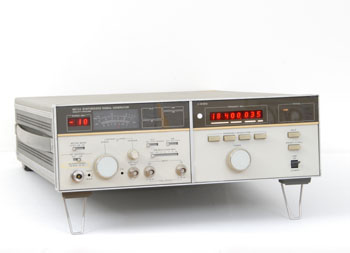 |
HP 8672A Microwave Synthesizer |
Broadband frequency synthesizers have been available in the VHF/UHF range since 1964 (HP 5100A, described at the top of this page). In 1971 the HP 8660 family of instruments (described above) introduced the concept of a synthesized signal generator with modulation and output level control. In 1975 the maximum frequency range of the 8660 family was raised to 2.6 GHz and phase modulation was included.
In the microwave range, before 1977, frequency sources had generally been narrow-band instruments, often covering one communication band or one octave. Wider frequency coverage had been obtained by means of collections of oscillators that could be switched on and off. In 1975 the broadband HP 86290A Sweeper Plug-In was the first to cover the entire 2-to-18-GHz range with a single YIG-tuned oscillator followed by a YIG-tuned harmonic multiplier.
The 8672A Synthesized Signal Generator, introduced in the November 1977, Hewlett Packard journal, combined frequency synthesis techniques with improved versions of the 86290A components to provide extremely accurate frequency coverage in the 2-to-18.6-GHz range. The 8672A is based on a 2-to-6.2-GHz frequency synthesizer followed by a YIG-tuned multiplier to provide 2 to 18 GHz frequency coverage. The 8672A RF output power is internally leveled and calibrated from +3 dBm to -120 dBm. Six metered frequency modulation ranges and two metered amplitude modulation ranges are provided for FM rates to 10 MHz and AM rates to 100 kHz. The 8672A is HP-IB programmable. All control settings are indicated on the front panel in either local or remote control mode.
| HP 8672A simplified block-diagram - From the Hewlett Packard Journal, November, 1977 Courtesy of Hewlett Packard Company |
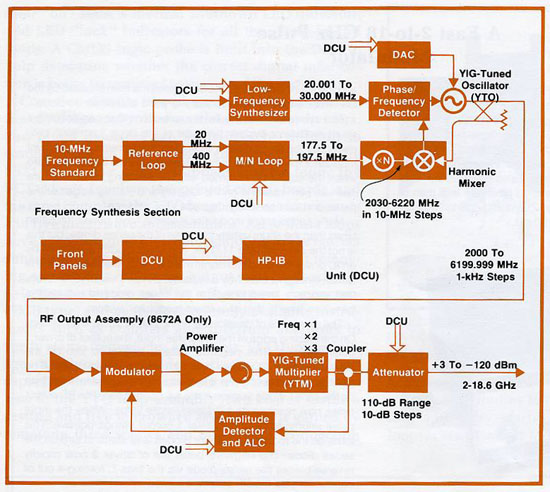 |
The two photos shown below are the top and bottom inside view of the 8672A Microwave Synthesizer . Comparing them to the 5100A inside views shown at the top of this page gives an immediate feeling of what the technology evolution was during the golden years of the 60s and 70s . Less than 15 years separate the concepts of these two instruments.

|
Use your scrollwheel to zoom in/out |
|
|
|
Top-Inside View of the 8672A Microwave Synthesizer |
| Bottom-Inside View of the 8672A Microwave Synthesizer |
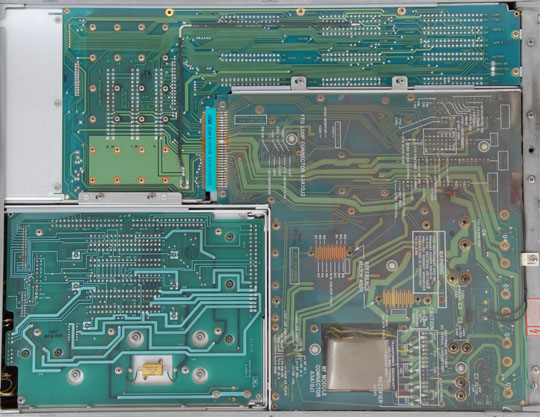 |
Application of a Microwave Synthesized Signal Generator |
|
Model 8672A Synthesized Signal Generator is designed to satisfy many applications in automatic test, communications, spectrum surveillance, and research and development.
|
down-link transmission frequencies are often separated by several hundred megahertz or more, the 8672A can perform as a local oscillator or test stimulus generator in either part of the system. Many systems require backup equipment in case of failures. Costs can often be significantly reduced by using a single multiband synthesized signal generator as the backup for several instruments.
|
From the Hewlett Packard Journal, November, 1977 - Courtesy of Hewlett Packard Company |
|
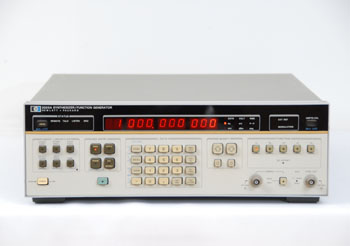 |
HP 3325A Synthesized Function Generator |
Just before the end of the 70s, in 1979, another advance in Fractional-N Synthesis technology permitted the production of the 3325A Synthesized Function Generator. The development of dedicated integrated circuits drasticaly reduced the quantity of discrete componants required to implement the Fractional-N synthesis technology in a variety of instruments.
The first to take advantage of this progress was the 3325A. The Model 3325A produces waveforms spanning 13 decades in frequency from 1 microHertz up to 21 MHz with synthesizer accuracy. Output waveforms can be sine waves, square waves, triangles and ramps with swept-frequency convenience. Output amplitude over the full frequency range is 1 mV to 10 V p-p into 50 Ohms. And like almost every new instrument at the end of the 70s, all necessary functions of the HP 3325A are HP-IB programmable.
| HP 3325A simplified block-diagram - From the Hewlett Packard Journal, January, 1979 Courtesy of Hewlett Packard Company |
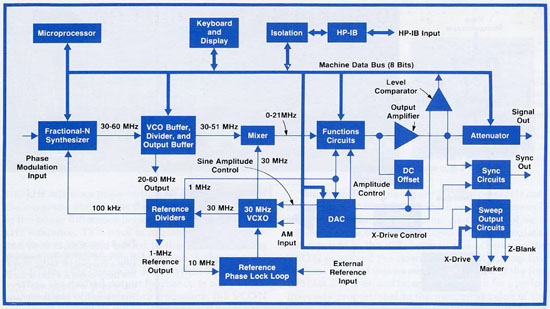 |